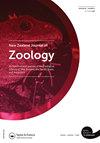入侵食肉动物和猎物种群的破坏性动态,以及捕食者的控制,影响了整个南阿尔卑斯山的kea生存率
IF 1.1
4区 生物学
Q3 ZOOLOGY
引用次数: 5
摘要
摘要:入侵性食肉动物正在威胁奥特亚的本土动物群,但其影响因时间、空间和物种而异。保护策略需要了解不同生态系统特有的捕食者-猎物动态,并允许长期的公会转变。为了建立这一知识,我们使用了一个跨越20年(1998-2001)的数据集,并跨越了几个以森林为主的南岛山地生态系统,对kea的生存能力进行了建模。kea是一种长寿的地面筑巢鹦鹉,物种范围广泛。与西方生态系统相比,东部生态系统的Kea存活率较低,在食肉动物入侵期间下降,在捕食者控制后上升。所有年龄和性别的Kea在觅食和栖息时都会成为白鼬和野猫的猎物,而不是在筑巢时。在所有生态系统中都发生了对粪便的掠夺,而在东部生态系统中,野猫的数量更多。在大多数情况下(成人 > 90%,青少年 > 70%),但在2020年至2021年期间,东部生态系统中白鼬和野猫的捕食达到峰值,使成年猫的存活率降至<60%。这一捕食高峰发生在啮齿动物数量锐减之后,啮齿动物是东部山毛榉林食肉动物的主要猎物。我们得出结论,捕食者对kea的影响集中在桅杆后的年份。提供了管理建议。本文章由计算机程序翻译,如有差异,请以英文原文为准。
Irruptive dynamics of invasive carnivores and prey populations, and predator control, affect kea survivorship across the Southern Alps
ABSTRACT Invasive carnivores are threatening the indigenous fauna of Aotearoa, but impacts vary with time, space and species. Conservation strategies require knowledge of predator-prey dynamics specific to different ecosystems and allowing for long-term guild shifts. To build this knowledge, we model the survivorship of the kea, a long-lived, ground-nesting parrot with an expansive species-range, using a dataset spanning two decades (1998–2021) and spanning several forest-dominated South Island montane ecosystems. Kea survivorship was lower in eastern ecosystems compared to western ones, depressed during carnivore irruptions, and elevated after predator control. Kea of all ages and both sexes fell prey to stoats and feral cats whilst foraging and roosting, not whilst nesting. Stoat depredation happened in all ecosystems, whereas feral cats featured more in eastern ones. Annual survivorship was high in most contexts (adults > 90%, juveniles > 70%), but a peak in stoat and feral cat predation in eastern ecosystems during 2020–2021 reduced adult survival to <60%. This predation peak followed a rodent population crash, the primary prey of carnivores in eastern beech forests. We conclude that predator impacts on kea are concentrated into post-mast years. Recommendations for management are provided.
求助全文
通过发布文献求助,成功后即可免费获取论文全文。
去求助
来源期刊
CiteScore
2.80
自引率
0.00%
发文量
20
审稿时长
>12 weeks
期刊介绍:
Aims: The diversity of the fauna of the southern continents and oceans is of worldwide interest to researchers in universities, museums, and other centres. The New Zealand Journal of Zoology plays an important role in disseminating information on field-based, experimental, and theoretical research on the zoology of the region.

 求助内容:
求助内容: 应助结果提醒方式:
应助结果提醒方式:


